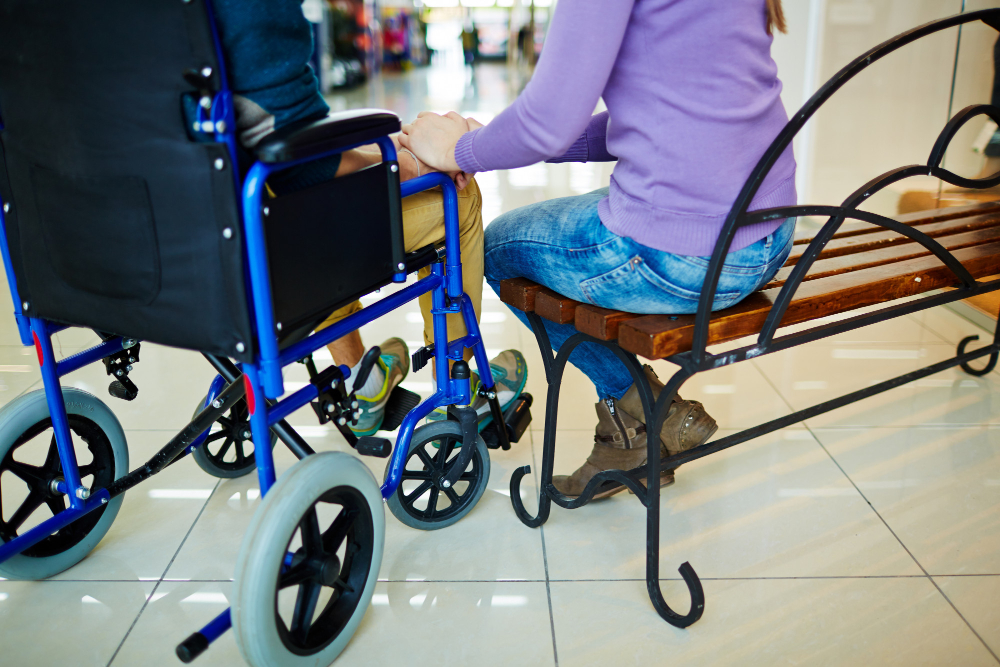Spinal Muscular Atrophy (SMA) is a genetic neurodegenerative disease that leads to progressive muscle weakness and paralysis and if left untreated, can lead to the most severe form and death. SMA has an incidence of 1 in 10,000 live births and can affect infants and adults of any age, race, or gender.1,2 The life of SMA patients can be very debilitating and short; nevertheless, the natural history of this disease is changing due to the significant advances and developments in SMA therapeutics.3
Causes
The main cause of SMA is the loss of or mutation in the survival motor neuron 1 (SMN1) gene, responsible for producing SMN protein needed to maintain healthy and functional motor neurons. In the absence of SMN protein, motor neurons begin to degenerate and become non-functional. They will no longer be able to send signals to muscles, leading to muscle weakening and eventually becoming smaller due to inactivity.1,2
SMN1 gene is located on chromosome No.5, where the neighbouring homologous SMN2 gene can partially compensate for the loss of SMN1. SMN2 is also called the “backup” gene as it can produce a small fraction of functional SMN protein (~ 10% of what SMN1 gene produces). All SMA patients have at least one copy of SMN2,4, and the more SMN2 genes a person has, the more functional SMN protein is available and the milder the SMA disease course is. SMA can be divided into 3 types according to the number of SMN2 copies available.1
Types of SMA
- Type 1 SMA
Type 1 SMA accounts for ~60% of SMA cases, and it is the most severe type, which if untreated, can lead to death or permanent ventilation by the age of 2. Patients with type 1 SMA have only 1-2 copies of SMN2. Its onset typically occurs at birth, where degeneration and loss of motor neurons start even shortly before birth and escalate, reaching >95% loss by 6 months of age. Untreated babies with this type of SMA will never be able to sit independently. Some of the other symptoms they experience include difficulty in breathing and swallowing, poor head control, poor muscle tone, and worsening muscle control.1,2
- Type 2 SMA
Type 2 SMA accounts for ~30% of SMA cases. Patients with type 2 SMA have 3-4 copies of SMN2, making type 2 SMA a bit milder than type 1 SMA. Onset occurs between 6 and 18 months, and if left untreated, the child will never be able to walk without support or a wheelchair. Patients with Type 2 SMA are unable to stand without support. They are able to sit independently, but even this ability might be lost by mid-teen age. They might also experience trembling in their fingers and some skeletal abnormalities like scoliosis and hip dislocation. Moreover, difficulty with feeding and breathing often develops later in the course. It is noted that more than 30% of type 2 SMA patients will die by age 25.1,2
- Type 3 SMA
Type 3 SMA accounts for ~10% of SMA cases. Patients with type 3 SMA have approximately the same number of SMN2 copies (3-4 copies) as that of type 2 SMA.
Onset typically occurs in early childhood to early adulthood (children 18 months or older). Although children with type 3 SMA achieve the ability to stand and to walk, they might lose it over time due to their legs being more severely affected than their arms. Untreated patients with SMA Type 3 have difficulty walking, running up and down the stairs.1,2
- Type 4 SMA
Patients with type 4 SMA have >4 copies of SMN2. The onset of symptoms usually occurs in adulthood (20s or 30s), after the individual has learned to how to stand and walk independently. Type 4 SMA is characterised by hypotonia (decreased muscle tone), affecting mainly the muscles used to walk and move the arms. Symptoms include fatigue, aching muscles, shaking of the fingers and hands, feeling of heaviness.1,5
Diagnosis
SMA is an autosomal recessive disorder where two copies of the mutated gene (one from each parent) are required to cause the disorder. If both parents are carriers of the mutated gene, then there is a 50% chance the child will also be a carrier, a 25% chance the child will have the disorder, and a 25% chance the child will be normal.2,3 Genetic testing can help determine the person’s chance of developing or passing on a genetic disorder. It can also help to determine the number of SMN2 genes and hence roughly predict the course of SMA.1
Early diagnosis is crucial in SMA as it allows for timely intervention to stop the irreversible motor loss and disease progression and lead to substantial improvement of neurodevelopmental outcomes.3 In July 2018, a landmark decision – the addition of SMA to the Recommended Uniform Screening Panel for newborns – was made for the SMA community in USA. This means every newborn baby diagnosed with SMA, can have early access to life-changing and life-saving treatments. As of 2022, 43 US states, 4 Canadian provinces, and 6 European countries are screening newborns for SMA. Other countries are still undergoing pilot studies to assess the benefits of newborn screening.3
Signs and Symptoms
SMA mainly affects the skeletal and respiratory systems. Symptoms associated with the:
– Skeletal system includes muscle weakness, fatigue, spasticity, bone fractures, contractures, hip dislocation, scoliosis, and kyphosis.
– Respiratory system: Breathing difficulties, respiratory infections, chest infections, respiratory failure
– Nervous system: impaired motor function,
– Gastrointestinal system: Dysphagia
– Heart: Cardiomyopathy1
Management and Treatment
The main therapeutic approach in SMA treatment is that involved in SMN-restoration, where the production of functional SMN protein is increased. So far, there are three drugs approved by the Food and Drug Administration (FDA): nusinersen (Spinraza), onasemnogene abeparvovec (Zolgensma), and risdiplam (Evrysdi).1,3,4
Nusinersen (brand name Spinraza) was approved by the FDA in 2016. It is the first milestone in SMA therapy used for the treatment of all types of SMA in children and adults. It is an antisense oligonucleotide that promotes SMN2 mRNA splicing, resulting in a higher number of SMN2 proteins. It is administered by intrathecal injection into the fluid surrounding the spinal cord. In all nusinersen clinical trials, Spinraza demonstrated a safe and clinically significant improvement in was able to improve motor function and survival in patients with infantile-onset SMA as well as later-onset SMA. Nevertheless, some patients experienced adverse effects such as infections and/or respiratory problems and post-lumbar puncture complications. 1,3,4
- Onasemnogene abeparvovec (brand name Zolgensma) was approved by the FDA in 2019 for the treatment of children under 2 years of age with a diagnosis confirmed by genetic testing. Zolgensma is a gene replacement therapy where adeno-associated virus serotype 9 (AAV9) is used as the viral vector to transfer cDNA – SMN. It is administered by a one-time intravenous injection. This therapy results in the long-term production of full-length SMN protein within motor neurons, improving muscle function and survival. Some patients had an adverse event of elevated liver enzymes. 1,3,4
- Risdiplam (brand name Evrysdi) was approved by the FDA in 2020 for the treatment of SMA in adults and children two months of age or older. Evrysdi is the latest treatment available for SMA and is a good alternative to the invasive nusinersen and onasemnogene. It is an oral medication designed to increase levels of the SMN protein by enhancing production from the SMN2 “backup” gene. Risdiplam can enter into the CNS and peripheral organs, offering a wider distribution over the body. Some of the adverse events reported were liver and male fertility abnormalities. 1,3,4
Other supplementary medications/ therapies/ devices may be used. These include:
– Muscle relaxants (ex. Botulinum toxin) may be used to reduce spasticity (ex. jaw spasms).
– Antidepressants may be used to treat anxiety/depression.
– Physical therapy, where exercise helps restore and maintain muscle strength and function.
– Occupational therapy helps to improve daily living and work skills.
– Speech-language pathologists might help with swallowing and speech problems.
– Respiratory devices, such as bilevel positive airway pressure (BiPAP), assist the lung muscles with the movement of air into and out of the lungs.
– A gastrostomy tube helps in passing the liquid nutrition from the mouth directly to the stomach, bypassing the weakened muscles of the throat (in case of painful chewing or swallowing).
– Vibrating vests help to loosen the mucus secretions
– A cough assist machine helps to remove secretions from the lungs.
– Standers, walkers, braces, and various powered and manual wheeled vehicles can help with standing and moving around.
– Back braces can slow the development of the spine.1
Conclusion
SMA is a rare and devastating genetic disease that can be properly managed and treated if the patient is diagnosed early. The earlier a treatment is started, the easier it is to attain motor function stabilization. The current therapeutic approaches are effective at extending the lives of SMA patients; however, they are not curative and hence not obsolete. Each treatment has its specific drawbacks and safety concerns. To evaluate the quality of life achieved in this gain of survival as well as determine the treatment’s cost-effectiveness, long-term safety, and efficacy data should be gathered on all current therapies.





